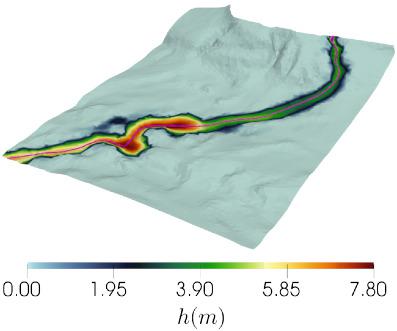当前位置:
X-MOL 学术
›
Int. J. Numer. Methods Fluids
›
论文详情
Our official English website, www.x-mol.net, welcomes your
feedback! (Note: you will need to create a separate account there.)
A shallow water event‐driven approach to simulate turbidity currents at stratigraphic scale
International Journal for Numerical Methods in Fluids ( IF 1.7 ) Pub Date : 2020-03-13 , DOI: 10.1002/fld.4828 Túlio L. Santos 1, 2 , Alexandre A. O. Lopes 2 , Alvaro L. G. A. Coutinho 1
International Journal for Numerical Methods in Fluids ( IF 1.7 ) Pub Date : 2020-03-13 , DOI: 10.1002/fld.4828 Túlio L. Santos 1, 2 , Alexandre A. O. Lopes 2 , Alvaro L. G. A. Coutinho 1
Affiliation

|
We present a new event‐driven approach that combines a shallow water flow model with a practical sedimentation technique to simulate the formation of turbidite depositional systems at a stratigraphic scale. The equations that govern turbidity currents dynamics are solved using a new finite element flux‐corrected transport scheme. In this sense, the low‐order formulation is built by adding a novel Rusanov‐like scalar dissipation scaled by a shock‐capturing operator to standard Galerkin equations. From it, the high‐order system is obtained by including antidiffusive fluxes linearized around the low‐order solution and limited with the Zalesak's algorithm, following a minmod prelimiter. Implicit time integration with adaptive time steps is performed with an iterative nonlinear scheme that linearizes source terms. Sedimentation is implemented by carrying five granulometric fractions (clay, silt, and fine, medium, and coarse sands) along evolved streaklines and radially scattering sediments that deposit filling the available depositional space and compacting the underneath sediment layers. The flow is computed while an event discharge into an area of interest is active, or the inflow current has not reached an equilibrium state. Afterward, the event deposition step is executed. Numerical results of our flow solver presented a good agreement with available exact and literature solutions, and the simulated sediment deposits suggest that our approach is well suited for stratigraphic scale simulations.
中文翻译:

浅水事件驱动方法在地层尺度上模拟浊流
我们提出了一种新的事件驱动方法,该方法将浅水流模型与实用的沉积技术相结合,以地层尺度模拟浊积岩沉积系统的形成。使用新的有限元通量校正的输运方案求解了控制浊度电流动力学的方程。从这个意义上讲,低阶公式是通过将新型的类似Rusanov的标量耗散(由震荡捕获算符缩放)添加到标准Galerkin方程中而建立的。从中,通过在minmod前置限制器之后,将围绕低阶解线性化并使用Zalesak算法限制的抗扩散通量包括在内,从而获得高阶系统。带有自适应时间步长的隐式时间积分是通过使源项线性化的迭代非线性方案执行的。沉积是通过沿演化的条纹携带五个粒度级分(粘土,淤泥,细砂,中砂和粗砂)并径向分散沉积物来沉积的,这些沉积物填充了可用的沉积空间并压实了下层沉积物。在事件放电激活到感兴趣区域或流入电流尚未达到平衡状态时计算流量。之后,执行事件沉积步骤。我们的流动解算器的数值结果与可用的精确解和文献解表明了很好的一致性,并且模拟的沉积物沉积表明我们的方法非常适合地层尺度模拟。和粗砂)沿着逐渐形成的条状线和放射状分散的沉积物,这些沉积物会填充可用的沉积空间并压实下面的沉积物层。在事件放电激活到感兴趣区域或流入电流尚未达到平衡状态时计算流量。之后,执行事件沉积步骤。我们的流动解算器的数值结果与可用的精确解和文献解表明了很好的一致性,并且模拟的沉积物沉积表明我们的方法非常适合地层尺度模拟。和粗砂)沿着逐渐形成的条状线和放射状分散的沉积物,这些沉积物会填充可用的沉积空间并压实下面的沉积物层。在事件放电激活到感兴趣区域或流入电流尚未达到平衡状态时计算流量。之后,执行事件沉积步骤。我们的流动解算器的数值结果与可用的精确解和文献解表明了很好的一致性,并且模拟的沉积物沉积表明我们的方法非常适合地层尺度模拟。执行事件沉积步骤。我们的流动解算器的数值结果与可用的精确解和文献解表明了很好的一致性,并且模拟的沉积物沉积表明我们的方法非常适合地层尺度模拟。执行事件沉积步骤。我们的流动解算器的数值结果与可用的精确解和文献解表明了很好的一致性,并且模拟的沉积物沉积表明我们的方法非常适合地层尺度模拟。
更新日期:2020-03-13
中文翻译:

浅水事件驱动方法在地层尺度上模拟浊流
我们提出了一种新的事件驱动方法,该方法将浅水流模型与实用的沉积技术相结合,以地层尺度模拟浊积岩沉积系统的形成。使用新的有限元通量校正的输运方案求解了控制浊度电流动力学的方程。从这个意义上讲,低阶公式是通过将新型的类似Rusanov的标量耗散(由震荡捕获算符缩放)添加到标准Galerkin方程中而建立的。从中,通过在minmod前置限制器之后,将围绕低阶解线性化并使用Zalesak算法限制的抗扩散通量包括在内,从而获得高阶系统。带有自适应时间步长的隐式时间积分是通过使源项线性化的迭代非线性方案执行的。沉积是通过沿演化的条纹携带五个粒度级分(粘土,淤泥,细砂,中砂和粗砂)并径向分散沉积物来沉积的,这些沉积物填充了可用的沉积空间并压实了下层沉积物。在事件放电激活到感兴趣区域或流入电流尚未达到平衡状态时计算流量。之后,执行事件沉积步骤。我们的流动解算器的数值结果与可用的精确解和文献解表明了很好的一致性,并且模拟的沉积物沉积表明我们的方法非常适合地层尺度模拟。和粗砂)沿着逐渐形成的条状线和放射状分散的沉积物,这些沉积物会填充可用的沉积空间并压实下面的沉积物层。在事件放电激活到感兴趣区域或流入电流尚未达到平衡状态时计算流量。之后,执行事件沉积步骤。我们的流动解算器的数值结果与可用的精确解和文献解表明了很好的一致性,并且模拟的沉积物沉积表明我们的方法非常适合地层尺度模拟。和粗砂)沿着逐渐形成的条状线和放射状分散的沉积物,这些沉积物会填充可用的沉积空间并压实下面的沉积物层。在事件放电激活到感兴趣区域或流入电流尚未达到平衡状态时计算流量。之后,执行事件沉积步骤。我们的流动解算器的数值结果与可用的精确解和文献解表明了很好的一致性,并且模拟的沉积物沉积表明我们的方法非常适合地层尺度模拟。执行事件沉积步骤。我们的流动解算器的数值结果与可用的精确解和文献解表明了很好的一致性,并且模拟的沉积物沉积表明我们的方法非常适合地层尺度模拟。执行事件沉积步骤。我们的流动解算器的数值结果与可用的精确解和文献解表明了很好的一致性,并且模拟的沉积物沉积表明我们的方法非常适合地层尺度模拟。











































 京公网安备 11010802027423号
京公网安备 11010802027423号